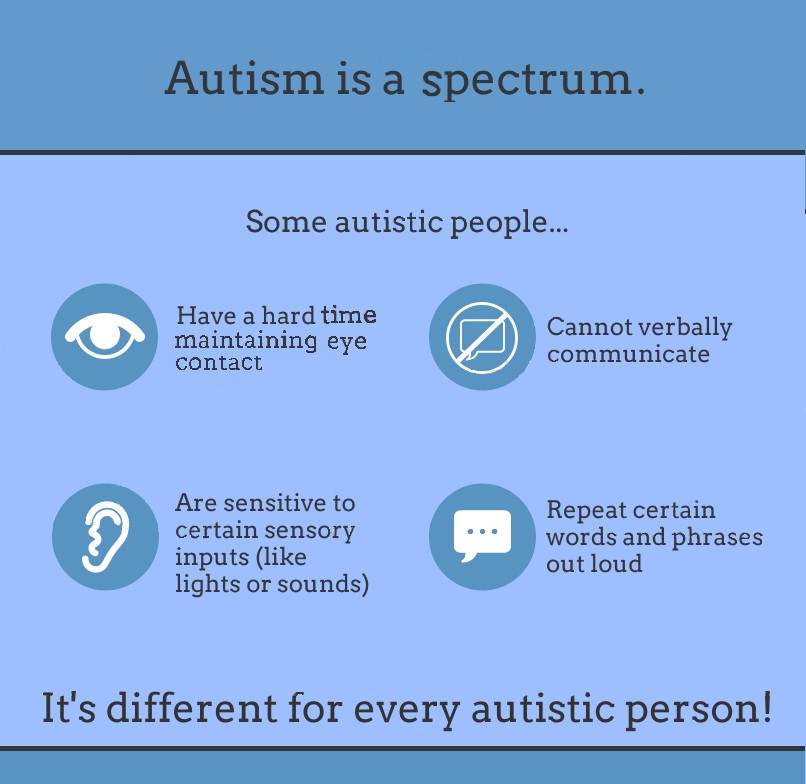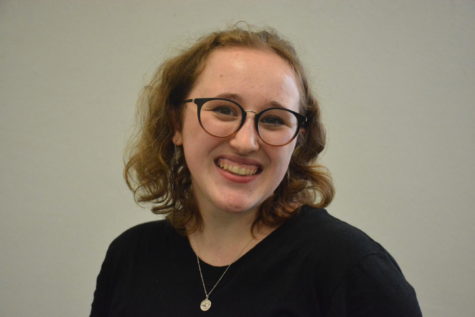World Autism Awareness Day: celebrating neurodivergence
“Autism is a spectrum,” and there are different characteristics of Autism Spectrum Disorder. Source: LifeLine Connections
April 2, 2021
Every April 2, the world celebrates Autism Awareness Day, yet so many people are unfamiliar with the characteristics of it. Autism Spectrum Disorder (ASD) is a neurological and developmental disorder that impacts how people learn, feel, move and communicate. It cannot go away or be cured, but that does not mean the disorder is a disease.
A misconception about ASD is that it looks the same in every autistic person or that every person with autism views the world the exact same way, but it is not that simple.
“The challenges are not necessarily with the students diagnosed with ASD,” category B special education teacher Katy Smallwood said. “People tend to lump everyone on the spectrum into the same box when it truly is a spectrum of strengths and unique characteristics.”
An ASD diagnosis may sound scary because of the prejudices against the autism community. Stigma exists because autistic people might act differently or have behaviors people do not understand. Some autistic people struggle with facial expressions and awareness of others, and without education on ASD, neurotypical people might experience that person as weird or awkward. In western culture, differences are not often celebrated and stigma and prejudice develop.
The diagnosis of ASD itself acts as a label that can lead to the discovery of helpful services and improve the person’s life. On the other hand, that label can also continue the stigma due to societal intolerance of anything that does not provide a sense of “normalcy.”
“I had to spend a lot of time explaining to my friends why my brother was different,” senior Keith Kahn said. “I think that there are many people who don’t know how to treat others who have ASD because they don’t know anyone with ASD. It’s not because they want to discriminate, but the inclusion is difficult because autistic people speak and act differently.”
Communication itself has been a difficult task between neurotypical and autistic people. Really, autistic people just use a different way to communicate, which neurotypical people should try to learn and use. According to the Autism Society, effective communication with autistic people includes speaking more slowly and directly, allowing time for the person to process the words and not using sarcasm or phrases with implied meanings.
“We tend to expect autistic people to adapt to others instead of others adapting to them,” Smallwood said. “Autistic people are just straightforward. That may come across as blunt or abrupt, but it’s just an easier communication route for them.”
One of the biggest contributors to the stigma of ASD is parental denial or ignorance of the disorder in their children. According to the New York Times, businesses can exploit parents who are struggling to take care of an autistic child by providing inadequate educational and family services with high costs. This struggle leads to a lack of resources provided for guardians in need of guidance or any further education on ASD itself.
“Working with parents and families, I have noticed it’s difficult for some to acknowledge that there could be something not typical about their child,” Smallwood said. “When you hear autism, you automatically put that person in a box, but we should be celebrating their strengths. These people on the spectrum have these incredible characteristics that give them opportunities in the workplace and help in society.”
Throughout the media, ASD has been portrayed as completely disabling or violent. A recent movie sparked controversy amongst social media users, both in and out of the autism community. “Music,” a movie created by singer Sia and released in February 2021, stars a neurotypical actress playing the role of an autistic character. This portrayal was seen as a mocking of ASD, due to scenes showing mannerisms that are seen as “stereotypical autism behavior.”
Additionally, a released clip of the movie showed the use of prone restraint, a position where a person is forced face down onto a solid surface. The violent restraint is mistakenly used on autistic people when they are overwhelmed or acting out, which has caused the deaths of Eric Parsa, Max Benson and so many other autistic people. This clip received heavy backlash as many people in the autism community feared that, by seeing the restraint on the television, neurotypical people would believe it to be harmless.
“People should not be scared of autism,” Smallwood said. “They’re just people, and everyone, both neurotypical and on the spectrum, has their own nuances that can be understood.”
In her TEDx Talk, artist-researcher Dawn-Joy Leong, who is also an autistic woman, voices her experiences on how she views the world with autism. She expresses that autistic people do not suffer from their ASD, but from the social discrimination and misrepresentation that comes with it in society. Her autism is used as an excuse to force her into silence, a common struggle experienced by the autism community as a result of the stigma they face.
“People know autism exists, but I’m not sure whether that is just because people and society have gotten older,” Kahn said. ”I certainly hear slurs less frequently, although I get a little mad when I do because they essentially equivocate intellectual disability to stupidity.”
Society as a whole needs to know that ASD is not a disease nor something that should be feared. It is a difference in mental processing. That’s it. To lead to a brighter future for autistic and neurotypical people, everyone needs to be open to adapting to each other’s differences because it will make for a more inclusive community.
“Because it’s a spectrum, strengths and needs require different supports,” Smallwood said. “Some people wear glasses, some are bad at math and some are on the spectrum. I think our society as a whole is getting wiser with some of these unique characteristics and finding ways to help strengthen these people.”




